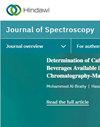Quantification of the Spectral Variability of Ore-Bearing Granodiorite under Supervised and Semisupervised Conditions: An Upscaling Approach
IF 2.1
4区 化学
Q4 BIOCHEMICAL RESEARCH METHODS
引用次数: 0
Abstract
Reflectance spectroscopy is a nondestructive, rapid, and easy-to-use technique which can be used to assess the composition of rocks qualitatively or quantitatively. Although it is a powerful tool, it has its limitations especially when it comes to measurements of rocks with a phaneritic texture. The external variability is reflected only in spectroscopy and not in the chemical-mineralogical measurements that are performed on crushed rock in certified laboratories. Hence, the spectral variability of the surface of an uncrushed rock will, in most cases, be higher than the internal chemical-mineralogical variability, which may impair statistical models built on field measurements. For this reason, studying ore-bearing rocks and evaluating their spectral variability in different scales is an important procedure to better understand the factors that may influence the qualitative and quantitative analysis of the rocks. The objectives are to quantify the spectral variability of three types of altered granodiorite using well-established statistical methods with an upscaling approach. With this approach, the samples were measured in the laboratory under supervised ambient conditions and in the field under semisupervised conditions. This study further aims to conclude which statistical method provides the best practical and accurate classification for use in future studies. Our results showed that all statistical methods enable the separation of the rock types, although two types of rocks have exhibited almost identical spectra. Furthermore, the statistical methods that supplied the most significant results for classification purposes were principal component analysis combined with k-nearest neighbor with a classification accuracy for laboratory and field measurements of 68.1% and 100%, respectively.监督和半监督条件下含矿花岗闪长岩光谱变异性的量化:一种升级方法
反射光谱学是一种无损、快速、易于使用的技术,可用于定性或定量地评估岩石成分。虽然它是一个强大的工具,但它也有其局限性,尤其是在测量显岩结构的岩石时。外部变异性仅反映在光谱学中,而不反映在经过认证的实验室对碎石进行的化学矿物学测量中。因此,在大多数情况下,未破碎岩石表面的光谱变异性将高于内部的化学-矿物学变异性,这可能会损害基于现场测量建立的统计模型。因此,研究含矿岩石并在不同尺度上评价其光谱变异性是更好地了解可能影响岩石定性和定量分析的因素的重要步骤。目的是量化光谱变异性的三种类型的蚀变花岗闪长岩使用完善的统计方法与升级方法。通过这种方法,样品在实验室监督的环境条件下和在半监督的条件下在现场进行测量。本研究进一步旨在总结哪种统计方法为未来的研究提供了最实用和准确的分类。结果表明,尽管两种岩石的光谱几乎相同,但所有的统计方法都能区分岩石类型。此外,为分类目的提供最显著结果的统计方法是主成分分析结合k近邻,其实验室和现场测量的分类精度分别为68.1%和100%。
本文章由计算机程序翻译,如有差异,请以英文原文为准。
求助全文
约1分钟内获得全文
求助全文
来源期刊

Journal of Spectroscopy
BIOCHEMICAL RESEARCH METHODS-SPECTROSCOPY
CiteScore
3.00
自引率
0.00%
发文量
37
审稿时长
15 weeks
期刊介绍:
Journal of Spectroscopy (formerly titled Spectroscopy: An International Journal) is a peer-reviewed, open access journal that publishes original research articles as well as review articles in all areas of spectroscopy.
 求助内容:
求助内容: 应助结果提醒方式:
应助结果提醒方式:


